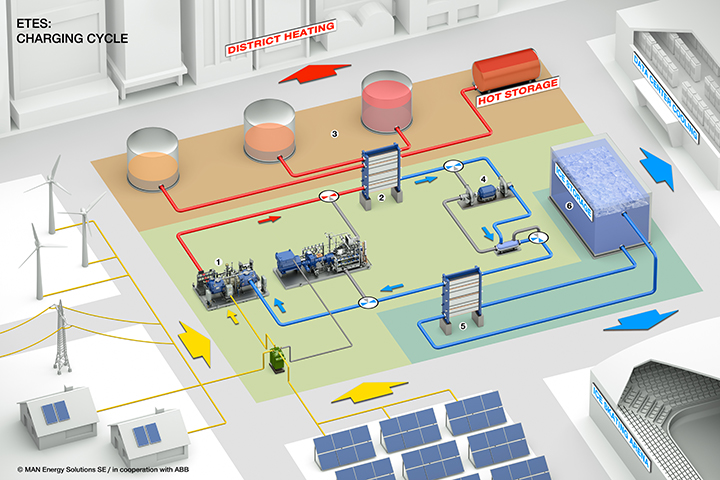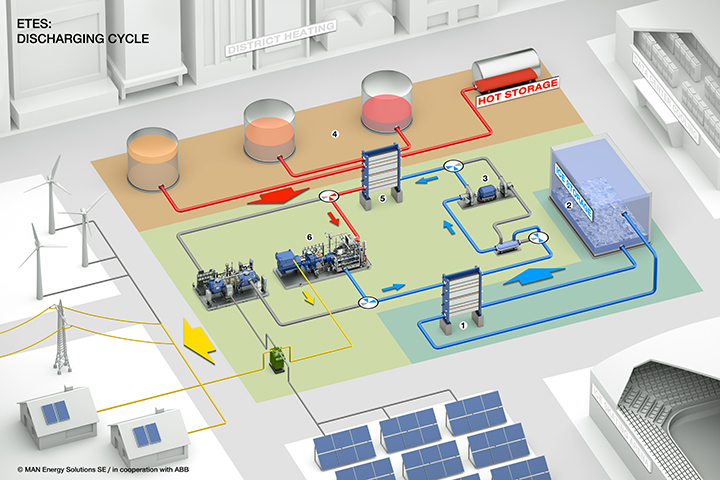Introducing ETES, the pioneering solution that facilitates the sector coupling of heating, cooling and electricity in the fight for decarbonization
MAN has long tried to bend the environment to his will: Persian engineers had already mastered the technique of creating ice in the winter and storing it for year-round use in the desert by 400 BC. As technology grew more sophisticated, ice cubes in summer or centrally-heated homes in winter were no longer such a problem with the advent of a regular electricity supply courtesy of power plants.
The need for decarbonization
Globally, the last quarter-century has been defined by fossil fuel and increased carbon emissions. Growing awareness of this destructive trend led the world community to a consensus at Kyoto and Paris, but evidence of the effectiveness of these agreements is scarce. Even financial crises and deindustrialization have failed to lower emissions and some countries are still building the dirtiest of coal-burning plants.
With the world’s population set to rise to 10 billion people by 2050, and the commensurate, huge rise in demand for electricity that will accompany it, the question remains: how can we supply the electricity required without an increase in carbon emissions?
Clearly, this electricity must come from near-zero-carbon sources. The latest report from REN21, the global renewable-energy-policy multi-stakeholder network, states that the need to decarbonize the energy system is generally agreed, but that no consensus has of yet been reached on how to achieve this. However, one of the report’s key findings is that reaching carbon-reduction goals largely depends on the use of renewable energy to generate heat and cooling. The report also states that heating and cooling account for 48% of global energy consumption and 39% of CO2 emissions because renewable sources deliver only 10% of the energy.
While renewable energy sources, such as wind and solar, offer inexhaustible sources of energy, major questions remain about their low density, diffuseness and intermittency. Improving these applications and harvesting usable electricity remain – at least currently – the best options for staving off the dystopian future that rising temperatures would bring to our small planet.

The ETES charging cycle
(1) The HOFIM™ turbo-compressor runs on surplus energy from renewable resources, compressing CO2 in the cycle, which is heated to 120°C.
(2) The CO2 is fed into a heat exchanger and heats the water.
(3) The hot water is stored in isolated tanks (3 atmospheric, 1 pressurized), each one at a separately defined temperature level.
(4) Still under high pressure, the CO2 is fed into an expander, which reduces the pressure. The CO2 is liquefied and cooled.
(5) The liquefied CO2 is again pumped through a heat exchange system; this time on the cold side of the system.
(6) Heat is taken from the surrounding water and ice is formed in the ice storage tank.
Enter ETES
A new approach to renewable applications could involve sector coupling, a term that refers to a number of electricity conversion, energy storage, and reconversion pathways that utilize surplus electric power, typically during periods where fluctuating renewable energy generation exceeds load.
A promising example of this is thermal-energy storage, which is a key measure in integrating mid-size to large capacities of renewables into the electrical grid. The technique involves absorbing large quantities of excess energy – thereby protecting the power grid from overload – and the timely re-injection of this additional energy into the grid, depending on demand.
In March 2018, MAN Energy Solutions Schweiz AG signed a cooperation agreement with ABB Switzerland for the development, production and commercialization of a three-way energy-management system. Known as ETES (Electro-Thermal Energy Storage), it is the only large-scale system on the market that is capable of using, storing and distributing heat, cold and electricity simultaneously.
Moreover, it is possible to distribute the stored cold and heat to different types of consumer. For instance, heat can be used for district heating, the food-processing industry, heating of public or commercial facilities, etc., whereas applications for the cold include cooling data-centers, process industry companies, facilities like shopping malls, university campuses, harbors, etc. MAN will provide the complete ETES system as a single solution, with ABB’s support as system partner.
Patrik Meli, Vice President, Head of Compressor Engineering at MAN Energy Solutions, said: “ETES is a unique energy-management system that fulfills the requirements of sector coupling, that’s the key. We can’t achieve the Paris agreement just thinking in these individual silos. When we think out of the box and combine these separate entities, that is the definition of sector coupling. Most energy demand worldwide is for heating and cooling, not in transport nor in electricity as is commonly thought.”
He continued: “The classic thinking has always been in terms of electricity in, electricity out. What we realized was that we need to handle electricity, heat and cold as a single entity rather than as individual commodities. If you’re able to do that, then you are able to create value because the price of heating and cooling is different to that of electricity.”The ETES discharging cycle
(1) Gaseous CO2 enters the heat exchanger on the cold side of the system, where it condenses because of the cold from the ice storage tank.
(2) The ice in the tank melts.
(3) The CO2 pump increases the pressure of the CO2 again.
(4/5) The CO2 passes through the heat exchanger and is heated by the water in the hot water storage tanks.
(6) The heat from the heated CO2 is fed into the power turbine, where the heat is converted back into electrical energy via a coupled generator. The electricity flows into the grid and is distributed to consumers.
How ETES works
ETES is a multifunctional energy-management system based on the reversible conversion of electrical energy into thermal energy via storage in the form of hot water and ice. The thermal energy can be reconverted either into electrical power or distributed directly from the thermal storage.
The system is scalable, site-independent, has a very low environmental impact and can be tailor-made for specific applications. Turbomachinery units and the patented thermodynamic cycle represent the core technology and competence of the plant.
During ETES’ charging cycle, electrical energy is converted into heat and cold, and stored in isolated tanks. During the discharging cycle, the reverse occurs. A closed CO2 cycle lies at the heart of the system with CO2 being alternately compressed and expanded, and the resulting heat and cold stored.
The turbomachinery technology and the process design of the charging and discharging cycles are the key elements of the energy-storage system. ETES features MAN’s hermetically sealed turbo compressor HOFIM™ within the charging cycle to compress the CO2 working fluid to its supercritical state at typically 140 bar and ca. 120°C.
Depending on the specific configuration, the grid-to grid efficiency of this process reaches approximately 50–55%. The use and distribution of heat or cold from the thermal storage increases the overall process efficiency up to 70%Customers
MAN Energy Solutions sees ETES as an innovative and modular solution for the energy storage, management and regulation of mid- to large-scale thermal and electrical consumers. As such, the company views potential markets for tailor-made ETES systems among industrial and/or municipal users.
Patrik Meli concluded: “Can you fulfill the demands of a city of, for example, 200,000 people in a completely green and CO2-neutral fashion, completely decarbonized? Can you deliver citizens’ demand for heating and cooling? Yes, you can with such an ETES system and, for me, that’s really a breakthrough in technology. ETES’ arrival is timely and now politicians are starting to listen. With ABB and MAN Energy Solutions in the lead, we have two strong, experienced companies promoting this exciting concept.”
Most energy demand worldwide is for heating and cooling, not in transport nor in electricity as is commonly thought.
